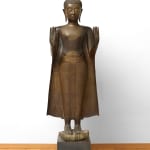Unknown
A late 17th Century Standing Buddha, cast in the Ayutthaya period and displays a strong influence of the Sukhothai style.
The Buddha displays with both hands the gesture of fearlessness.
Hands possibly restored.
In Ayutthaya period, Buddha images appear more different gestures than the other previous period under the influences of Lopburi, U Thong, and Sukhothai styles. This standing Buddha adopted the Sukhothai style of sculpture showing an oval face, long limbs and a smooth modelling of clothing. A distinctive Sukhothai type of flame is attached to the top of the ushnisha rather than a band presenting between the hairline and the forehead.
The facial expression of the Buddha appears more stern, with the arching eyebrows, eyes carved in narrowed lines, and a slight smile. Standing image displays the gesture of Abhaya Mudra, which symbolizes the dispelling of fear, protection, and reassurance.
This piece is remarkable for the high level of bronze casting demonstrated in the depiction of Buddha, detail and texture of ushnisha. Beyond physical representation, it is able to deliver peace, inner-strength, and fulfilment for the viewers.



